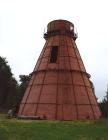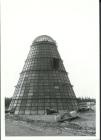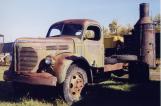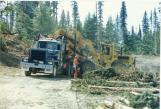1
Beehive burner acquired from Le Pas Lumber after burners were phased out in 1997.
1997
Railway and Forestry Museum , Prince George, British Columbia, Canada

2
Beehive burners were originally used to burn the excess wood that could not be used in lumber production. Because of the harmful effects of air pollution and today's ability to use nearly 100 % of the log, they are no longer in use. This burner was acquired by Le Pas Lumber after burners were phased out in 1997.
3
Beehive Burner
2000
Northwood Lumber , Prince George, British Columbia, Canada

4
Prior to 2003, beehive burners were still in operation in several locations around the province of British Columbia. All burners were expected to be phased out by 2004.
5
Lloyd Bros. logging operation on Cluculz Lake
1980
Cluculz Lake, British Columbia, Canada

6
The central placement of the beehive burner in this photo illustrates the importance of burners to the operation of mills. Many photos like this document the growth of the forestry industry in the area.
7
Photo of a beehive and a train going by.
1990
Northern British Columbia, Canada

8
While many communities benefited from forestry operations, this image illustrates the economic decline of communites as smaller mills were phased out.
9
REO Truck
1954
Railway and Forestry Museum , Prince George, British Columbia, Canada

10
This REO Lumber Truck is over fifity years old and was operated by the Rossetti Lumber Company. One popular use of these trucks was delivering railway ties, which illustrates the close relationship between the railway and forestry industries.
11
Contemporary Logging Truck
21 December 2005
Northern British Columbia, Canada

12
This image was found in an album documenting the operations of Northwood Pulp and Timber Ltd. The forest industry is based upon the harvesting and transportation of trees.
13
Off Highway Logging Truck
21 December 2005
Northern British Columbia, Canada

14
This is a photo of a contemporary logging truck. There are two types of trucks used in the logging industry which are designed for either on-highway or off-highway use. The main difference between these two types of trucks are the width of the bunks and the size of the load (restricted for highway transport)

